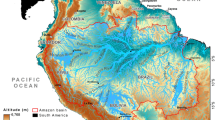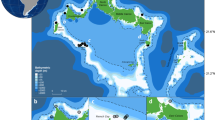Abstract
Ontogenetic niche shifts are common among animals, yet most studies only investigate niche shifts at the population level, which may overlook considerable differences among individuals in the timing and dynamics of these shifts. Such divergent behaviors within size-/age-classes have important implications for the roles a population—and specific age-classes—play in their respective ecosystem(s). Using acoustic telemetry, we tracked the movements of juvenile bull sharks in the Shark River Estuary of Everglades National Park, Florida, and found that sharks increased their use of marine microhabitats with age to take advantage of more abundant resources, but continued to use freshwater and estuarine microhabitats as refuges from marine predators. Within this population-level ontogenetic niche shift, however, movement patterns varied among individual sharks, with 47 % of sharks exhibiting condition-dependent habitat use and 53 % appearing risk-averse regardless of body condition. Among sharks older than age 0, fifty percent made regular movements between adjacent regions of the estuary, while the other half made less predictable movements that often featured long-term residence in specific regions. Individual differences were apparently shaped by both intrinsic and extrinsic factors, including individual responses to food-risk trade-offs and body condition. These differences appear to develop early in the lives of bull sharks, and persist throughout their residencies in nursery habitats. The widespread occurrence of intraspecific variation in behavior among mobile taxa suggests it is important in shaping population dynamics of at least some species, and elucidating the contexts and timing in which it develops and persists is important for understanding its role within communities.








Similar content being viewed by others
References
Barton BT (2010) Climate warming and predation risk during herbivore ontogeny. Ecology 91:2811–2818
Bell AM, Hankison SJ, Laskowski KL (2009) The repeatability of behavior: a meta-analysis. Anim Behav 77:771–783
Bolnick DI, Svanback R, Fordyce JA, Yang LH, Davis JM, Hulsey CD, Forister ML (2003) The ecology of individuals: incidence and implications of individual specialization. Am Nat 161:1–28
Bolnick DI, Amarasekare P, Araujo MS, Burger R, Levine JM, Novak M, Rudolf VHW, Schreiber SJ, Urban MC, Vasseur DA (2011) Why intraspecific trait variation matters in community ecology. Trend Ecol Evol 26:183–192
Bransky JW, Dorn NJ (2013) Prey use of wetland benthivorous sunfishes: ontogenetic, interspecific and seasonal variation. Environ Biol Fish 96:1329–1340
Brien ML, Webb GJ, Lang JW, McGuinness KA, Christian KA (2013) Born to be bad: agonistic behavior in hatchling saltwater crocodiles (Crocodylus porosus). Behavior 150:737–762
Castro JI (2011) The sharks of North America. Oxford University Press, Cary
Childers DL (2006) A synthesis of long-term research by the Florida Coastal Everglades LTER Program. Hydrobiologia 569:531–544
Clark CW (1994) Antipredator behaviour and the asset protection principle. Behav Ecol 5:159–170
Clark CW, Mangel M (2000) Dynamic state variable models in ecology. Methods and applications. Oxford University Press, Cary
Conrath CL, Musick JA (2010) Residency, space use and movement patterns of juvenile sandbar sharks (Carcharhinus plumbeus) within a Virginia summer nursery area. Mar Freshwater Res 61:223–235
Curtis TH, Adams DH, Burgess GH (2011) Seasonal distribution and habitat associations of bull sharks in the Indian River Lagoon, Florida: a 30-year synthesis. Trans Am Fish Soc 140:1213–1226
Davis S, Childers DL, Lorenz JJ, Wanless HR, Hopkins TE (2005) A conceptual model of ecological interactions in the mangrove estuaries of the Florida Everglades. Wetlands 25:832–842
Day T, Young KA (2004) Competitive and facilitative evolutionary diversification. Bioscience 54:101–109
de Roos AM, Leonardsson K, Persson L, Mittlebach GG (2002) Ontogenetic niche shifts and flexible behavior in size-structured populations. Ecol Monogr 72:271–292
Espinoza M, Farrugia TJ, Lowe CG (2011) Habitat use, movements and site fidelity of the gray smooth-hound shark (Mustelus californicus Gill 1863) in a newly restored southern California estuary. J Exp Mar Biol Ecol 401:63–74
Gross MR (1991) Salmon breeding behavior and life history evolution in changing environments. Ecology 72:1180–1186
Gross MR, Charnov EL (1980) Alternative male life histories in bluegill sunfish. Proc Natl Acad Sci 77:6937–6940
Gross MR, Repka J (1998) Game theory and inheritance in the conditional strategy. In: Dugatkin LA, Reeve HK (eds) Game theory and animal behavior. Oxford University Press, New York, pp 168–187
Grubbs RD (2010) Ontogenetic shifts in movements and habitat use. In: Carrier JC, Musick JA, Heithaus MR (eds) Sharks and their relatives. II. Biodiversity, adaptive physiology, and conservation. CRC, Boca Raton, pp 319–350
Guttridge TL, Gruber SH, Franks BR, Kessel ST, Gledhill KS, Uphill J, Krause J, Sims DW (2012) Deep danger: intera-specific predation risk influences habitat use and aggregation formation of juvenile lemon sharks Negaprion brevirostris. Mar Ecol Prog Ser 445:279–291
Hays GC, Kennedy H, Frost BW (2001) Individual variability in diel vertical migration of a marine copepod: why some individuals remain at depth when others migrate. Limnol Oceanogr 46:2050–2054
Heithaus MR (2007) Nursery areas as essential shark habitats: a theoretical perspective. Am Fish Soc Symp 50:3–13
Heithaus MR, Frid A, Wirsing AJ, Dill LM, Fourqurean JW, Burkholder D, Thomson J, Bejder L (2007a) State-dependent risk-taking by green sea turtles mediates top-down effects of tiger shark intimidation in a marine ecosystem. J Anim Ecol 76:837–844
Heithaus MR, Burkholder D, Hueter RE, Heithaus LI, Pratt HL Jr, Carrier JC (2007b) Spatial and temporal variation in shark communities of the Lower Florida Keys and evidence for historical population declines. Can J Fish Aquat Sci 64:1302–1313
Heithaus MR, Delius BK, Wirsing AJ, Dunphy-Daly MM (2009) Physical factors influencing the distribution of a top predator in a subtropical oligotrophic estuary. Limnol Oceanogr 54:472–482
Heithaus MR, Frid A, Vaudo JJ, Worm B, Wirsing AJ (2010) Unraveling the ecological importance of elasmobranchs. In: Carrier JC, Musick JA, Heithaus MR (eds) Sharks and their relatives. II. Biodiversity, adaptive physiology, and conservation. CRC, Boca Raton, pp 611–637
Heupel MR, Carlson JK, Simpfendorfer CA (2007) Shark nursery areas: concepts, definition, characterization and assumptions. Mar Ecol Prog Ser 337:287–297
Holland KN, Wetherbee BM, Peterson JD, Lowe CG (1993) Movements and distribution of hammerhead shark pups on their natal grounds. Copeia 2:495–502
Houston A, Clark A, McNamara J, Mangel M (1988) Dynamic models in behavioural and evolutionary ecology. Nature 332:29–34
Lowry D, de Castro ALF, Mara K, Whiteneck LB, Delius B, Burgess GH, Motta P (2009) Determining shark size from forensic analysis of bite damage. Mar Biol 156:2483–2492
Matich P, Heithaus MR (2012) Effects of an extreme temperature event on the behavior and age structure of an estuarine top predator (Carcharhinus leucas). Mar Ecol Prog Ser 447:165–178
Matich P, Heithaus MR (2014) Multi-tissue stable isotope analysis and acoustic telemetry reveal seasonal variability in the trophic interactions of juvenile bull sharks in a coastal estuary. J Anim Ecol 83:199–213
Matich P, Heithaus MR, Layman CA (2010) Size-based variation in inter-tissue comparisons of stable carbon and nitrogen isotopic signatures of bull sharks (Carcharhinusn leucas) and tiger sharks (Galeocerdo cuvier). Can J Fish Aquat Sci 67:877–885
Matich P, Heithaus MR, Layman CA (2011) Contrasting patterns of individual specialization and trophic coupling in two marine apex predators. J Anim Ecol 80:295–304
Mittelbach GG, Ballew NG, Kjelvik MK (2014) Fish behavioral types and their ecological consequences. Can J Fish Aquat Sci 71:1–18
Neer JA, Thompson BA, Carlson JK (2005) Age and growth of Carcharhinus leucas in the northern Gulf of Mexico: incorporating variability in size at birth. J Fish Biol 67:370–383
Newsome SD, Etnier MA, Monson DH, Fogel ML (2009) Retrospective characterization of ontogenetic shifts in killer whale diets via δ13C and δ15N analysis of teeth. Mar Ecol Prog Ser 374:229–242
Odum EP (1980) The status of the three ecosystem-level hypotheses regarding salt marsh estuaries: tidal subsidy, outwelling and detritus-based food chains. In: Kennedy V (ed) Estuarine perspectives. Academic Press, New York, pp 485–495
Ogden JC, Davis SM, Jacobs KJ, Barnes T, Fling HE (2005) The use of conceptual ecological models to guide ecosystem restoration in south Florida. Wetlands 25:795–809
Papastamatiou YP, Lowe CG, Caselle JE, Friedlander AM (2009) Scale-dependent effects of habitat on movements and path structure of reef sharks at a predator-dominated atoll. Ecology 90:996–1008
Pfennig DW, Rice AM, Martin RA (2007) Field and experimental evidence for competition’s role in phenotypic divergence. Evolution 61:257–271
Post DM (2003) Individual variation in the timing of ontogenetic niche shifts in largemouth bass. Ecology 84:1298–1310
Regnier T, Labonne J, Gaudin P, Bolliet V (2012) Influence of energetic status on ontogenetic niche shifts: emergence from the redd is linked to metabolic rate in brown trout. Oecologia 168:371–380
Rosenblatt AE, Heithaus MR (2011) Does variation in movement tactics and trophic interactions among American alligators create habitat linkage? J Anim Ecol 80:786–798
Rosenblatt AE, Heithaus MR, Mather ME, Matich P, Nifong JC, Ripple WJ, Silliman BR (2013) The roles of large top predators in coastal ecosystems: new insights from long-term ecological research. Oceanography 26:156–167
Sih A, Bell A, Johnson JC (2004) Behavioral syndromes: an ecological and evolutionary overview. Trends Ecol Evol 19:372–378
Simard M, Zhang K, Rivera-Monroy VH, Ross MS, Ruiz PL, Castaneda-Moya E, Twilley RR, Rodriguez E (2006) Mapping height and biomass of mangrove forests in Everglades National Park with SRTM elevation data. Photogramm Eng Remote Sens 72:299–311
Simpfendorfer CA, Freitas GG, Wiley TR, Heupel MR (2005) Distribution and habitat partitioning of immature bull sharks (Carcharhinus leucas) in a southwest Florida estuary. Estuaries 28:78–85
Sinclair ARE, Arcese P (1995) Population consequences of predation-sensitive foraging: the Serengeti wildebeest. Ecology 76:882–891
Skulason S, Smith TB (1995) Resource polymorphisms in vertebrates. Trends Ecol Evol 10:366–370
Smith TB, Skulason S (1996) Evolutionary significance of resource polymorphisms in fishes, amphibians, and birds. Annu Rev Ecol Syst 27:111–133
Videler JJ, Wardle CS (1991) Fish swimming stride by stride: speed limits and endurance. Rev Fish Biol Fish 1:23–40
Werner EE, Gilliam JF (1984) The ontogenetic niche and species interactions in size-structured populations. Annu Rev Ecol Syst 15:393–425
Wilbur HM (1980) Complex life cycles. Annu Rev Ecol Syst 11:67–93
Wiley TR, Simpfendorfer CA (2007) The ecology of elasmobranches occurring in the Everglades National Park, Florida: implications for conservation and management. Bull Mar Sci 80:171–189
Yang LH, Rudolf VHW (2010) Phenology, ontogeny and the effects of climate change on the timing of species interactions. Ecol Lett 13:1–10
Acknowledgments
Funding for this project was provided by the National Science Foundation to the Florida Coastal Everglades LTER Program (DBI0620409, DEB9910514, DRL0959026) and Florida International University’s Marine Sciences Program. We thank the many volunteers who assisted with shark fishing. Special thanks to Adam Rosenblatt for establishing the array of acoustic receivers and helping with downloading data, and providing analytical support. Thanks to Andrew Fritz for developing software for managing movement data and providing analytical support. Thanks also to Joel Trexler for providing logistical and analytical support for this project. Thanks to Philip Stoddard for providing comments on earlier versions of the manuscript. Research was approved by and conducted under the protocols of Florida International University’s Institutional Animal Care and Use Committee, and in accordance with sampling permits EVER-2011-SCI-0031, EVER-2009-SCI-0024, and EVER-2007-SCI-0025 granted by Everglades National Park.
Author information
Authors and Affiliations
Corresponding author
Additional information
Communicated by Aaron J. Wirsing.
Appendix 1
Appendix 1
Periodograms of FFT for: (1) a 2-year-old shark that did not exhibit periodic movements (54,802; top four panels); (2) a 1-year-old shark that exhibited periodic movements between TB and RB (54,800; middle four panels); and (3) a 2-year-old shark that exhibited periodic movements between TB and SR (4,562; bottom four panels)

Rights and permissions
About this article
Cite this article
Matich, P., Heithaus, M.R. Individual variation in ontogenetic niche shifts in habitat use and movement patterns of a large estuarine predator (Carcharhinus leucas). Oecologia 178, 347–359 (2015). https://doi.org/10.1007/s00442-015-3253-2
Received:
Accepted:
Published:
Issue Date:
DOI: https://doi.org/10.1007/s00442-015-3253-2




